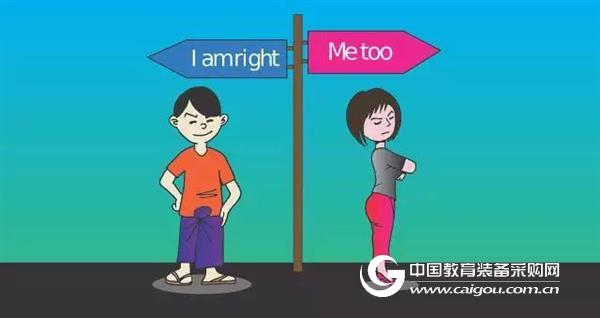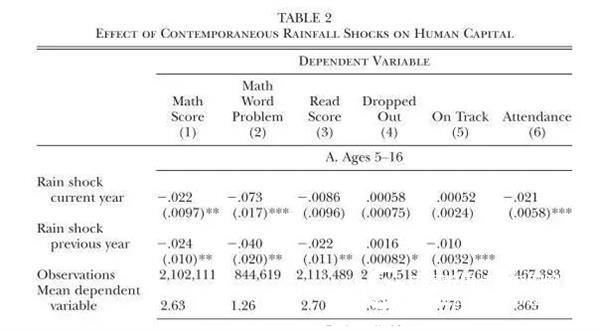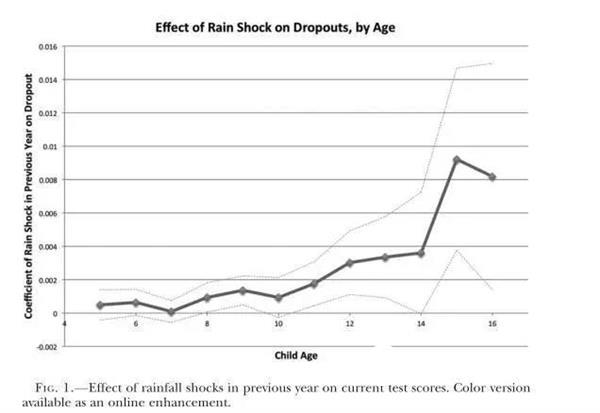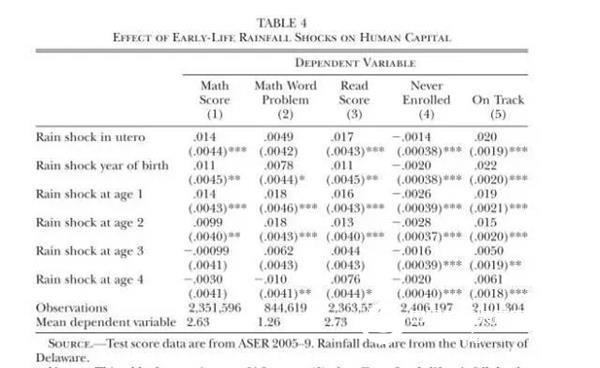Can rain actually affect human capital investment?
What rain is the most intuitive experience for you?

Someone said: Cool
Some people say: Rainwater is abundant
Someone said: No drought
.......
In fact, you are all right!

For some people, rain may actually affect the investment in human capital. Let's take a look at how Shah M and Steinberg BM are similar to the three-stage human capital production and investment model that changes with age by constructing investment and time allocation. The use of wage changes caused by the impact of rainfall in rural areas of India analyzed the impact of wage changes on current and long-term human capital investment.
I. Introduction
Does high wage income bring high human capital investment? The usual research holds positive opinions, but in fact, some studies believe that the role of high wages is exactly the opposite. If the latter research conclusion is established, it means that the rising opportunity cost brought about by rising wages will cause the children of low-income families to choose to leave the school for work, which will not only bring about continuous increase in inequality but also affect the long-term of a country. Economic Growth. Shah & Steinberg's “Dought of Opportunities: Contemporaneous and Long-Term Impacts of Rainfall Shocks on Human Capitalâ€, published in the Journal of Political Economy, builds three stages of human capital production and investment models that vary with age through investment and time allocation. Using wage changes caused by the impact of rainfall in rural areas of India, the impact of wage changes on current and long-term human capital investment was analyzed.
Second, human capital investment model
Suppose the family has one parent and one child; the child survives three periods; period 1, the child is too young to go to school and can only consume; period 2, the child consumes, and has 1 unit of time to study or work; time 3, family From the children's human capital accumulation gains. The family's total utility function is:

In the above formula, ct is the consumption level of period t, V(e3) is the household income obtained from human capital in period 3, and β is the depreciation factor.
Assume that wt is the unit of human capital wages for period t, h is the parent's human capital, and parents get wth income; period 1, the family's total income is w1h. Assume that et is the human capital of the child during period t, and the child gains the benefits of wtet. S2 is the child's study time in period 2, then (1-s2) is the working time of the child during this period; accordingly, the total family income of period 2 is: w2[h+(1-s2)e2].

The t-period human capital depends on the t-1 human capital and the t-1 human capital investment. The human capital investment can be either consumption or school education. Therefore, the human capital of the three-period model can be expressed as:

In turn, the family solves the following function to obtain the optimal solution:

Through the above equation, the author analyzes the impact of school-age wages and infant wages on school education and human capital accumulation.
Third, the data
A. Annual Education Status Data (ASER). The data includes the educational test scores of children aged 5-16 years in each rural area of ​​India from 2005-2009; the test includes digital issues, mathematics applications, and reading skills.
B. National sample survey data (NSS). According to the NSS data, labor participation rates, enrollment rates, and wages can be known.
C. Rainfall data. Used to measure rainfall for a given region in a given year; the author defines a year where rainfall in a particular region is above the 80th percentile as a positive shock, and a rainfall below the 20th percentile. The year is defined as a negative shock; in addition, the author defines the positive shock as 1, the negative shock as -1, and the other types as 0.
D. Rainfall in India. Although there is a large body of literature demonstrating the relationship between rainfall shocks and wages, the authors still tested using NSS data and found that positive rainfall shocks increase wages.
Fourth, empirical
A Effect of School-age Wage Increase on School Education and Human Capital
The actual analysis uses the current rainfall impact to analyze its impact. The estimated model is as follows:

In the above formula, in Sijty, i is the student, j is the region, t is the year of birth, and y is the year; for s2, the attendance rate and the dropout are used in the empirical study; for e3, the test scores such as mathematics, reading, etc. are used in the paper and whether or not to be retained. To measure. In addition, the model also controlled the rainfall in the area where it was young, controlled the fixed effect of the region, age, and survey year, and clustered at the district level.
Window A of Table 2 reports the impact of current rainfall on human capital between 5 and 16 years of age. Among them, the estimated coefficient of mathematics achievement is -0.02, which means that compared to the rainfall-rich period, the mathematics scores of drought years are 0.04 percentage points higher than the abundant years of rain; similarly, the mathematics application problems are 0.14 percentage points higher, but the reading scores No effect. Students in drought years have higher attendance rates than rainy years. In addition, the abundant rainwater of the previous year will reduce the students' scores on various examinations, increase the dropout rate, and reduce the probability of not leaving grades. At the same time, the author's discussion of the age group also found that the impact on older children (11-16) was even greater.

Figure 1 shows the effect of lag phase 1 rainfall impact on dropout rates at different ages. It can be found that the possibility of dropping out of school after 11 years of age is greater; this age group is an important stage of the transition from primary to secondary education, and rainy years of job opportunities have led to more students leaving school

In addition, the authors also examined the impact of rainfall shocks on individuals’ main activities; in rainy years, children are less likely to report that attending school is the main activity they participate in, which is 2 percentage points lower than the drought year; more likely to report work Their main activity is 1 percentage point higher than the year of drought; the older it is, the greater this effect is.
B. Effects of Infant Wage on School Education and Human Capital
The empirical analysis used the rainfall impact from the fetal development to the age of 4 years to analyze its impact on school education and human capital; unlike model A, model B controls the household fixed effect.

The authors found that from fetal development to 2 years of age, abundant rainfall helps to improve math performance, mathematics application problems and reading ability; from fetal development to 4 years of age, drought years increase the children's non-entrance rate and improve children's repetition rate . This shows that the increase in wages during early childhood will promote investment in education and human capital accumulation. The effect of 3-4 years of age will be small, and the key period of income effect will be 0-2 years old.

At the same time, the author also examined the impact of wages on infant consumption during early childhood, and found that in famine years, children’s body weight was lower. Consistent with existing research, during periods of abundant rainfall, children’s consumption was higher.
C. Does the rainfall impact have a long-term effect?
Using NSS data, the authors analyzed the impact of rainfall shocks on the total number of years of education during fetal development to 16 years of age. As a result, it was found that this effect is sustained, and the positive impact of rainfall will reduce the total number of years of education; the most significant age effect is at the age of 11-13, which is an important turning point from elementary school to junior high school; At that time, the positive impact of rainfall will result in a 0.23 year reduction in the total number of years of education compared to normal years.
V. Other possible explanations
A. Healthier children
If drought can reduce the probability of a child suffering from an epidemic, it will also result in the accumulation of high human capital for children in drought years. It is generally believed that high rainfall is related to malaria, and malaria has large regional differences. It is possible to examine the impact of regional malaria differences on academic performance. However, the results show that the impact of rainfall on malaria-prone areas does not affect children's test scores. Further, the authors found that the impact of rainfall did not affect the health of children aged 5-16 years. The relevant indicators show that children did not have a healthier year in drought than in years with abundant rainfall.
B. School lunch
In November 2001, India began to provide lunch for public elementary schools; the possible problem is that schools are more likely to provide lunch in arid years, under which incentives parents are more likely to send their children to school in drought years. This test found in the article that the hypothesis does not hold; schools are more likely to provide lunch in rain-rich years than in dry years; because schools have more resources in rainy years.
C. Teacher attendance
Higher wages in rich rainfall years mean that teachers’ attendance rates will fall in years with abundant rainfall, leading to lower human capital? In fact, this phenomenon cannot happen in India; teachers are high Wages occupations, the difference between agricultural harvest wages in good years and poor years only account for a very small portion of teachers' salaries. The empirical test also found that the attendance rate of teachers did not show a significant decline in the good years.
D. Selective Questions in Synchronous Regression
Does ASER's sample have selectivity? Are high-capacity children less likely to be surveyed when rainfall is high? If this is the case, there will be an upward bias in the estimation results. However, there is no such problem with the ASER design mechanism. Investigators are randomly assigned to households to participate in surveys when children are more likely to be at home; if children do not appear in the first survey, they will be required to conduct a second survey. .
If the year is rich in rainfall, students leave their area, which can also result in biased results. However, the migration in rural India is very low. The authors also used NSS data to determine whether family members had migrated in the past 6 months and found that the impact of rainfall shocks on migration was close to zero and not significant.
E. Selective migration in juvenile regression
In order to control the impact of selective migration, the author controls the family fixed effect in the juvenile regression model. If a child is hit by rainfall during the second year, the brothers and sisters who are larger or smaller than the family will migrate when the family moves. This means that the children in the treatment group will migrate with the children in the control group. Controlling the fixed effect of households means that one child can be compared with other children in the family and the impact of family migration can be ignored.
F. Fertility and Mortality Options
In the regression analysis of childhood, what we actually observe is the children who have survived the disaster years. If drought increases infant and child mortality rates, this can lead to biased outcomes. Compared with children who have not survived, those children who were chosen to survive survive healthier and better education. However, on the other hand, women may postpone or change their fertility decisions in the face of drought. They may wait until the drought years before choosing pregnant and having children. If drought affects fertility options, this will lead to results because the child in the drought year is Negatively selected. If this is the case, changes within the family will not affect the test results. However, in fact, there is very little difference in the regression results between control and non-controlling family fixed effects.
VI. Conclusions and Inspiration
This paper uses the exogenous impact of rainfall to analyze the impact of wages on human capital. It was found that positive productivity shocks resulted in low enrolment rates, low attendance and low test scores; this was mainly due to the fact that when wages increased, children would participate in more family production activities or work outside the home. In addition, an analysis of the childbearing period found that children who experienced early positive productivity shocks had higher test scores, were more likely to receive education at school, and had lower drop-out rates. This is related to the dynamic complementary theory in the production function of human capital. Early education investment can not only increase the level of human capital, but also increase the investment income of human capital. The conclusion in the article implies that the wage increase caused by productivity shocks in low-income countries may reduce investment in human capital. If low-income countries want to increase school enrollment and attendance, they must not only consider reducing tuition fees but also considering the opportunity cost. There are similar analyses in China, such as Zhang Chuanchuan (2015) analyzing the impact of increased non-agricultural employment opportunities on individual education decisions; the authors found that employment growth from export expansion reduces the enrollment rate of high schools and universities, which is not only detrimental to the reduction of urban and rural areas. The education and income gap will also have an adverse effect on long-term economic growth.

2. Thickened material, better load bearing.
3. Multi-purpose organizer solution
Use our clear storage boxes to help pack away your summer clothes
Our storage boxes will protect your things from dust
We have a wide variety of storage boxes to meet any storage needs
Household Series,Storage Basket,Housewares Organizer,Home Storage And Organisation
SY INTERNATIONAL (CN) CO.,LTD , https://www.syplasticbox.com